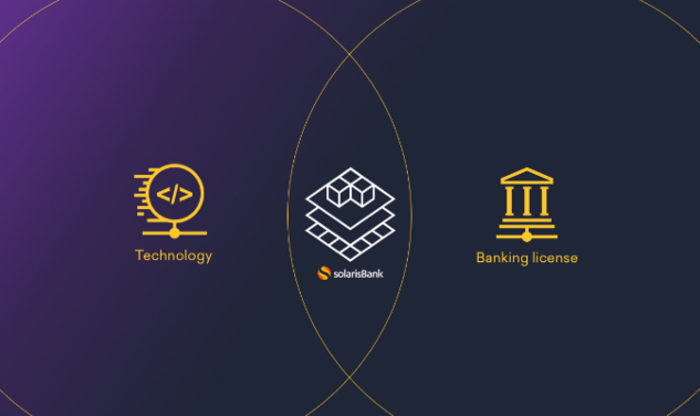Neobanks don’t need to be “real banks” to compete in banking
4 minute read


solarisBank CCO Marko Wenthin says that neobanks and challenger banks don’t need to be “real banks” to compete in banking.
As Chris wrote in his ’57 banks’ post, the neobank market is overcrowded and many won’t survive. That’s the harsh, but simple truth. What are all these banks (or banks-to-be) trying to achieve? An exit to an incumbent bank? Or to build a sustainable business?
Either way, the big question is: Does the market need that many banks to have their own licences and banking tech? Does a fintech need to be a proper “bank” to compete in banking? The answer is a resounding no.
For me, it’s clear as day: why would you bother to raise the massive amount of money required, obtain a banking licence, build banking technology, and perform constant compliance activities if there was an easier way to achieve the same results?
Why would you wait a year and a half — at minimum — before getting your product to market? Why wouldn’t you cooperate with a partner bank and focus on shipping a great product to your customers?
But I realise there are smart people out there who think building a full-fledged bank is a good idea, otherwise there wouldn’t be so many new entrants in Europe and the UK. So let’s have a look at what I think their reasoning could be:
Argument 1:
Neobanks can reach sustainability and become profitable businesses on their own, and they need modern technology to be sustainable for the future. Therefore, neobanks should have their own licences and infrastructure.
I agree with the premise but reject the conclusion.
Customers turn to neobanks because they provide a user experience that incumbent banks can’t. As long as they feel secure, customers don’t care where the underlying banking technology comes from. A neobank will live or die based on its ability to continuously delight its customers. The underlying technology is only relevant if it impedes that ultimate goal.
As a neobank, why would you take on the massive task of becoming (and remaining!) a bank when it costs you millions in capital, delays your time-to-market by years, and most importantly defocuses you from the main task of delighting your customers? Even if you nail the task of building a bank, you don’t have a sustainable business in the long run if you don’t deliver a world-class customer experience. There are some neobanks out there who’ve done the former and ignore the latter. I worry for them.
Some might argue that fintechs need banking licences in the long run because they need to cross-sell other high-margin products, such as consumer loans, to be sustainable. That is definitely one way to reach sustainability, but who says the products have to be your own? There are a number of fintechs that earn commissions by offering other companies’ products to their customers, including loans from “real” banks. The value you get from serving the customer has nothing to do with being a real bank and owning the products you sell — it’s only from delivering valuable services to customers.
Argument 2:
Incumbent banks’ legacy systems are terrible. They can’t make products people want without modern banking infrastructure. One way for them to stay relevant is to buy a neobank and migrate their businesses over to a modern system. Therefore, they will buy licensed neobanks that have built modern banking systems.
Again, I agree with the premise, but I don’t agree with the conclusion.
What do incumbent banks actually want? Is it fancy banking systems? Or to offer cutting-edge, pioneering products that redefine the customer’s relationships with their bank? The banking system is just a means to an end, the foundation on which the customer experience is built. In 2017, saying you need a modern banking system in-house in order to build innovative products is like saying you need servers in your office to run a website. Could you have servers in your office? Yes. Do you have to? No, and it makes little sense to.
Banking-as-a-Platform (BaaP) promises to transform banking the same way that cloud-hosting and cloud-computing has transformed the internet; you don’t need a data centre full of servers to run an enterprise-scale business today, and you won’t need your own banking systems in the future either.
Neobanks can be equally attractive, if not superior, acquisition targets without their own banking licences or systems. That is, as long as they build banking products that blow their customers away and manage to procure the banking services needed to do that.
With BaaP, fintechs can start fast, prove their concepts and pivot their business models until they find product/market fit in their quest to change banking. This way, they invest their time, creativity and investors’ money in real change — a better customer experience — and not in mimicking incumbents in a more fashionable way.
If it doesn’t work out, fair enough — at least you focused on the right things. If it does work out, and for whatever reason you decide to become a “real bank”, it isn’t an irreversible decision. You can always apply for a licence later. Our friends and Berlin neighbours at N26, the most successful European neobank, have done exactly that. I doubt they would have made such an impact if they had focused their time and resources on getting a licence back in 2014. Instead, they started lean and created the standout neobank reference case that everyone is chasing.
So no matter the long-term strategy of a neobank, whether to exit to an incumbent or strive for sustainable independence, starting as a proper “bank” and building your own banking infrastructure from scratch doesn’t make much sense to me.
My advice to the 57 “banks”? Forget the old paradigm of building your own banking systems. Stay nimble, get to market quickly and focus on delighting your customers. Do that, and you’ll be one of the lucky ones to survive.

